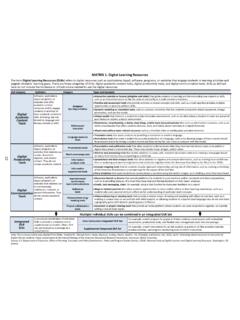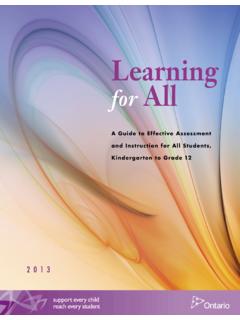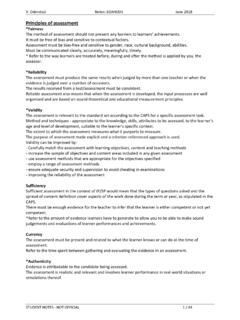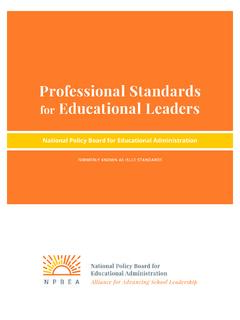Transcription of Michigan Math Standards
1 RIGOR RELEVANCE RELATIONSHIPS RIGOR RELEVANCE RELATIONSHIPS RIGOR RELEVANCE RELATIONSHIPS RIGOR RELEVANCE RELATIONHIPS RIGOR RELEVAN RELATIONHIPS RIGOR RELEVANCE RELATIONHIPS RIGOR RELEVANCE RELATION RIGOR RELEVANCE RELATIONSHIPS RIGOR RELEVANCE RELATIONSHIPS RIGOR RELEVANCE RELATIONSHIPS RIGOR RELEVANCE RELATIONHIPS RIGOR RELEVAN Michigan K-12 Standards Mathematics Michigan State Board of Education Kathleen N. Straus, President Bloomfield Township John C. Austin, Vice President Ann Arbor Carolyn L. Curtin, Secretary Evart Marianne Yared McGuire, Treasurer Detroit Nancy Danhof, NASBE Delegate East Lansing Elizabeth W. Bauer Birmingham Daniel Varner Detroit Casandra E. Ulbrich Rochester Hills Governor Jennifer M.
2 Granholm Ex Officio Michael P. Flanagan, Chairman Superintendent of Public Instruction Ex Officio MDE Staff Sally Vaughn, Deputy Superintendent and Chief Academic Officer Linda Forward, Director Office of Education Improvement and Innovation Welcome Welcome to the Michigan K-12 Standards for Mathematics, adopted by the State Board of Education in 2010. With the reauthorization of the 2001 Elementary and Secondary Education Act (ESEA), commonly known as No Child Left Behind (NCLB), Michigan embarked on a Standards revision process, starting with the K-8 mathematics and ELA Standards that resulted in the Grade Level Content Expectations (GLCE). These were intended to lay the framework for the grade level testing in these subject areas required under NCLB. These were followed by GLCE for science and social studies, and by High School Content Expectations (HSCE) for all subject areas.
3 Seven years later the revision cycle continued with Michigan working with other states to build on and refine current state Standards that would allow states to work collaboratively to develop a repository of quality resources based on a common set of Standards . These Standards are the result of that collaboration. Michigan s K 12 academic Standards serve to outline learning expectations for Michigan s students and are intended to guide local curriculum development. Because these Mathematics Standards are shared with other states, local districts have access to a broad set of resources they can call upon as they develop their local curricula and assessments. State Standards also serve as a platform for state-level assessments, which are used to measure how well schools are providing opportunities for all students to learn the content required to be career and college ready.
4 Linda Forward, Director, Office of Education Improvement and Innovation Vanessa Keesler, Deputy Superintendent, Division of Education Services Mike Flanagan, Superintendent of Public Instruction table of Contents Introduction 3 Standards for mathematical Practice 6 Standards for mathematical Content Kindergarten 9 Grade1 13 Grade2 17 Grade3 21 Grade4 27 Grade5 33 Grade6 39 Grade7 46 Grade8 52 High School Introduction High School Number and Quantity 58 High School Algebra 62 High School Functions 67 High School Modeling 72 High School Geometry 74 High School Statistics and Probability 79 Glossary 85 Sample of Works Consulted 91 Introduction Toward greater focus and coherence
5 Mathematics experiences in early childhood settings should concentrate on (1) number (which includes whole number, operations, and relations) and (2) geometry, spatial relations, and measurement, with more mathematics learning time devoted to number than to other topics. Mathematical process goals should be integrated in these content areas. MathematicsLearning in Early Childhood, NationalResearchCouncil, 2009 The composite Standards [of Hong Kong, Korea and Singapore] have a number of features that can inform an international benchmarking process for the development of K 6 mathematics Standards in the First, the composite Standards concentrate the early learning of mathematics on the number, measurement, and geometry strands with less emphasis on data analysis and little exposure to algebra. The Hong Kong Standards for grades 1 3 devote approximately half the targeted time to numbers and almost all the time remaining to geometry and measurement.
6 Ginsburg,Leinwand and Decker, 2009 Because the mathematics concepts in [ ] textbooks are often weak, the presentation becomes more mechanical than is ideal. We looked at both traditional and non-traditional textbooks used in the US and found this conceptual weakness in both. Ginsburg et al., 2005 There are many ways to organize curricula. The challenge, now rarely met, is to avoid those that distort mathematics and turn off students. Steen, 2007 For over a decade, research studies of mathematics education in high-performing countries have pointed to the conclusion that the mathematics curriculum in the UnitedStates must become substantially morefocused andcoherentin orderto improve mathematics achievementin deliver on thepromiseof common Standards , the Standards must address the problem of a curriculum that is a mile wide and an inch deep.
7 TheseStandards area substantial answerto that challenge. Itis importanttorecognize that fewerstandards are no substituteforfocused fewerstandards wouldbe easy todoby resortingtobroad, generalstatements. Instead, theseStandards aimfor clarity and specificity. Assessing the coherence of a set of Standards is more difficult than assessing Schmidt and RichardHouang (2002)have said that content Standards and curricula are coherent if they are: articulated over time as a sequence of topics and performances that are logical and reflect, where appropriate, the sequential or hierarchical nature of the disciplinary content from which the subject matter derives. That is, what and how students are taught should reflect not only the topics that fall within a certain academic discipline, but also the key ideas that determine how knowledge is organized and generated within that discipline.
8 This implies IntrodUCtIon | 3 that to be coherent, a set of content Standards must evolve from particulars ( , the meaning and operations of whole numbers, including simple math facts and routine computational procedures associated with whole numbers and fractions) to deeper structures inherent in the discipline. These deeper structures then serve as a means for connecting the particulars (such as an understanding of the rational number system and its properties). (emphasis added) TheseStandards endeavortofollow sucha design, not onlybystressingconceptual understandingofkey ideas, but alsoby continuallyreturningto organizing principles such as place value or the properties of operations to structure those ideas. In addition, the sequence of topics and performances that is outlined in a body of mathematics Standards must also respect what is known about how students learn.
9 AsConfrey (2007) points out, developing sequenced obstacles and challenges for the insights about meaning that derive from careful study of learning, would be unfortunate and unwise. In recognition of this, the development of theseStandards began withresearch-based learningprogressions detailing what is known today about how students mathematical knowledge, skill, and understanding develop over time. Understanding mathematics TheseStandards define whatstudents should understand andbe abletodoin their study of mathematics. Asking a student to understand something means asking a teacher to assess whether the student has understood it. But what does mathematical understanding look like?One hallmark of mathematical understanding is the ability to justify, in a way appropriate to the student s mathematical maturity, why a particular mathematical statement is true or where a mathematical rule difference betweenastudent who can summona mnemonicdevicetoexpandaproduct such as(a + b)(x + y)and a student who canexplain where the who canexplain the rule understands the mathematics, and may have a better chance to succeed at a less familiar task such asexpanding(a + b + c)(x + y).
10 Mathematical understanding and procedural skill are equally important, and both are assessable using mathematical tasks of sufficient richness. TheStandards setgrade-specificstandards butdo not define the intervention methods or materials necessary to support students who are well below or well alsobeyond the scopeof theStandardsto define the fullrangeof supports appropriatefor English language learners and forstudents with special the same time, allstudents musthave the opportunity to learn and meet the same high Standards if they are to access the knowledge and skills necessary in their post-school should beread as allowingfor the widest possiblerangeofstudentsto participate fully from the outset, along with appropriate accommodations to ensure maximum participatonofstudents with special education ,forstudents with disabilitiesreading should allowfor useofBraille, screenreadertechnology, or other assistive devices.

















